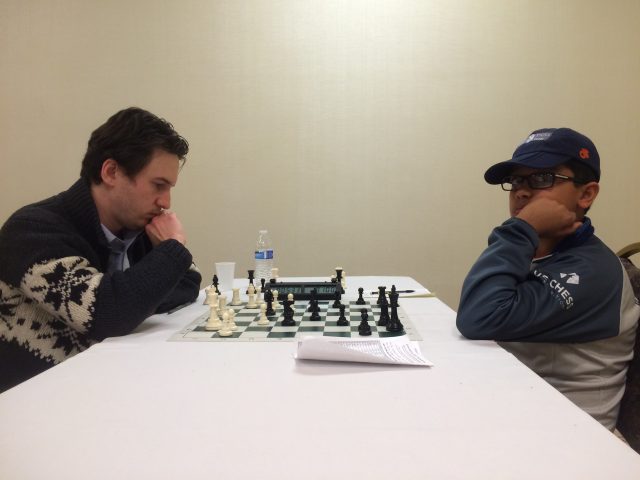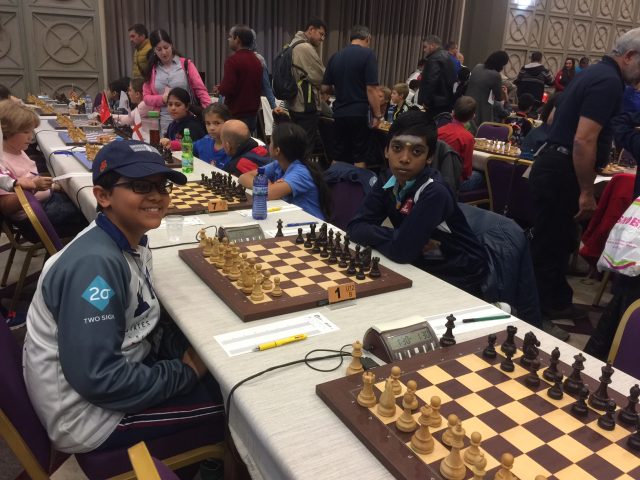
The first time Nikhil Kumar played in the National Congress a couple of years ago at age 10, his performance in the Under 2000 section was unremarkable. “I didn’t do so well,” recalled Kumar, who only scored three points in his first National Congress tournament back in 2014
But when Kumar played in the National Congress in Philadelphia this past Thanksgiving weekend, the newly minted National Master joined two GMs in a four-way tie for first place in the premier section — and subsequently won on tiebreaks — by scoring 5 out of 6 points after he drew one IM and drew against another GM — with the Black pieces, mind you — in the final round.
“He’s on fire now,” said GM Sergey Erenburg, who drew by repetition against Kumar in Round 6 of the six-round tournament.
“He’s probably the strength of at least an International Master,” Erenburg said of Kumar, who achieved the rank of NM this past September.
Erenburg said he initially thought he could squeeze a victory out of his game against Kumar but ultimately found the task too difficult.
“It was a tough game. I thought I had some pressure, a slight advantage, but my opponent defended very well,” Erenburg said of his Round 6 game against Kumar.
Asked about the game ending in draw by repetition, Erenburg said: “I can’t deviate because otherwise I would either lose a bishop or enter an inferior end game. Probably it’s still a draw but I cannot win.”
[pgn]
[Event "National Chess Congress"]
[Site "?"]
[Date "2016.11.27"]
[White "Erenburg, Sergey"]
[Black "Kumar, Nikhil"]
[Result "1/2-1/2"]
[ECO "B12"]
[WhiteElo "2647"]
[BlackElo "2210"]
[PlyCount "102"]
[EventDate "2016.??.??"]
1. e4 c6 2. d4 d5 3. e5 Bf5 4. Nf3 e6 5. Be2 Ne7 6. O-O c5 7. c4 Nbc6 8. dxc5
d4 9. Qb3 Qd7 10. Rd1 Ng6 11. Nc3 Bxc5 12. Qb5 b6 13. Na4 Ncxe5 14. Qxd7+ Nxd7
15. Nxd4 Bxd4 16. Rxd4 e5 17. Rd2 O-O 18. b3 Nf4 19. Bf1 Nf6 20. Bb2 Ne4 21.
Rdd1 f6 22. f3 Nc5 23. Nc3 Bd3 24. g3 Bxf1 25. Kxf1 Nfe6 26. b4 Na6 27. Nd5 Rf7
28. a4 Rd8 29. Bc3 Rfd7 30. Ke2 Nac7 31. Nxc7 Nxc7 32. Rxd7 Rxd7 33. b5 Ne6 34.
a5 Kf7 35. axb6 axb6 36. Ra8 Rc7 37. Kd3 Nc5+ 38. Kc2 Nd7 39. Kd3 Nc5+ 40. Kc2
Nd7 41. Kb3 Nc5+ 42. Ka3 Nd3 43. Ra6 Rxc4 44. Kb3 Rc7 45. Rxb6 Nc1+ 46. Kb2
Nd3+ 47. Kb3 Nc1+ 48. Kb2 Nd3+ 49. Kb3 Nc1+ 50. Kb2 Nd3+ 51. Kb3 Nc1+ 1/2-1/2
[/pgn]

“He has a bright future,” Erenburg said of Kumar. “As long as he works hard and has the support of his family, which he has.”
Indeed, Kumar’s father,
Alok Kumar, professor and chair of finance department at the University of Miami, attributed his son’s success to an “amazing investment” in coaching, namely, Cuban-born IM Alejandro Moreno — the chess coach at the University of Miami — and Israeli GM Boris Avrukh.
“He started playing chess only four years ago,” the elder Kumar said of his son. “In four years, his progress has been phenomenal. It wouldn’t have happened without a proper coach.”
At the same time, the younger Kumar — who recently won
gold at Open Under 12 section of the World Cadets in Batumi — has been doing his part by putting in some serious study time.
He estimated that — after schoolwork — he spends three hours on chess every day. Part of his study involves looking at GM games on ChessBase or reading books by authors such as Andy Soltis. Online chess videos, he said, constitute only a small part of his study regimen.
Asked for his favorite GM, Kumar said he looks up to former world champion Viswanathan Anand. “I like Vishy Anand because he’s also from India like me,” said Kumar, a Floridian whose parents are from India.
Here are some other noteworthy games from the 2016 National Congress, which drew about 600 registrants, according to officials at the Continental Chess Association.
 Nikhil Kumar at the World Youth in Batumi, Georgia, here vs. IM Rameshbabu Praggnanandhaa
Nikhil Kumar at the World Youth in Batumi, Georgia, here vs. IM Rameshbabu Praggnanandhaa[pgn]
[Event "National Chess Congress"]
[Site "?"]
[Date "2016.11.25"]
[White "Scott, Harold"]
[Black "Bela Kis, Lorand"]
[Result "1-0"]
[ECO "A48"]
[WhiteElo "2078"]
[BlackElo "2195"]
[PlyCount "65"]
[EventDate "2016.??.??"]
1. d4 Nf6 2. Nf3 g6 3. Bf4 Bg7 4. c3 d6 5. h3 O-O 6. e3 Nbd7 7. a4 c6 8. Be2 b6
9. O-O a6 10. b4 Bb7 11. Qb3 Ne4 12. Rd1 Qc7 13. Nbd2 c5 14. Nxe4 Bxe4 15. Ng5
e5 16. Bh2 Bb7 17. Bc4 Nf6 18. Bxf7+ Rxf7 19. dxe5 c4 20. Qa2 dxe5 21. Nxf7
Kxf7 22. f4 Ne4 23. fxe5 Ke6 24. Qe2 h5 25. Rd4 b5 26. Qc2 Qc6 27. Rad1 Bxe5
28. Bxe5 Kxe5 29. Rd7 Rf8 30. R1d4 Rf6 31. g4 h4 32. Rxe4+ Qxe4 33. Qh2+ 1-0[/pgn]
[pgn]
[Event "National Chess Congress"]
[Site "?"]
[Date "2016.11.26"]
[White "Zhang, Alan"]
[Black "Moradiabadi, Elshan"]
[Result "1-0"]
[ECO "B06"]
[PlyCount "46"]
[EventDate "2016.??.??"]
1. e4 g6 2. d4 Bg7 3. Nc3 a6 4. Be3 b5 5. Qd2 Bb7 6. f3 d6 7. O-O-O Nd7 8. d5
c6 9. dxc6 Bxc6 10. Kb1 Rc8 11. Bd4 Ngf6 12. g4 e5 13. Bf2 b4 14. Nce2 O-O 15.
Ng3 Qa5 16. g5 Ne8 17. h4 Nc7 18. a3 Rb8 19. Bc4 Rfd8 20. N1e2 Nc5 21. Be1 Qb6
22. Qxb4 Qa7 23. Qa5 Nb7 1-0[/pgn]
[pgn]
[Event "National Chess Congress"]
[Site "?"]
[Date "2016.11.26"]
[White "Kumar, Nikhil"]
[Black "Glek, Igor"]
[Result "1-0"]
[ECO "A85"]
[WhiteElo "2210"]
[BlackElo "2561"]
[PlyCount "77"]
[EventDate "2016.??.??"]
1. d4 e6 2. c4 f5 3. Nf3 Nf6 4. Nc3 Bb4 5. Bd2 O-O 6. e3 a5 7. Bd3 b6 8. O-O
Bb7 9. a3 Bxc3 10. Bxc3 Ne4 11. Bxe4 fxe4 12. Nd2 a4 13. Qg4 Rf5 14. d5 Rg5 15.
Qe2 exd5 16. f4 Rf5 17. Bxg7 Qh4 18. g3 Qh3 19. Bc3 Na6 20. Rf2 Nc5 21. g4 Rf7
22. Rg2 Ne6 23. Rf1 Raf8 24. cxd5 Bxd5 25. Rg3 Qh4 26. Nc4 d6 27. Rf2 b5 28.
Na5 c6 29. Qd2 h6 30. Nxc6 Bxc6 31. Qxd6 Bd7 32. Qe5 Ng7 33. g5 Re8 34. Qd5 Be6
35. Qxb5 Rd8 36. gxh6 Bh3 37. Rd2 Rxd2 38. Qe8+ Kh7 39. Qxf7 1-0[/pgn]
In other news, this US Chess writer decided it was time to enforce Rule 15A of the US Chess Federation’s Rules of Chess, and not allow my opponents to write down their moves before they make them — and sometimes erase them and write down other moves.
“What are you writing?” I asked my opponent, who shall remain nameless out of respect.
“I’m just writing down ideas,” my opponent responded defiantly. “I’m indecisive.” As if that weren’t a big deal. As if GM Wesely So didn’t get forfeited in the US Championship in 2015 for doing something similar, albeit not exactly the same.
“If you do it again I’m telling the tournament director,” I said after he did it a second time. I then proceeded to tell a TD I saw approaching my board because I thought he had heard the commotion and was there to investigate or intervene. The TD advised the player to make his moves first and then record them.
I don’t know if the young player was rattled, but soon after he played 26. Ne3:
He probably thought he was disconnecting my rooks. Turns out, it was a fatal error, which I had been eagerly awaiting and responded to immediately with 26 …. Rxe3! White now realizes he cannot capture the rook with the f-pawn or else he will get mated with Qg2. The game proceeded 27. Qxe3 Rxe3, and things were pretty much a cinch from there.
Find full standings at http://www.nationalchesscongress.com/ Jamaal Abdul-Alim is a Washington, DC-based journalist who covers higher education and chess. You can follow him on Twitter @dcwriter360. The first time Nikhil Kumar played in the National Congress a couple of years ago at age 10, his performance in the Under 2000 section was unremarkable. “I didn’t do so well,” recalled Kumar, who only scored three points in his first National Congress tournament back in 2014
But when Kumar played in the National Congress in Philadelphia this past Thanksgiving weekend, the newly minted National Master joined two GMs in a four-way tie for first place in the premier section — and subsequently won on tiebreaks — by scoring 5 out of 6 points after he drew one IM and drew against another GM — with the Black pieces, mind you — in the final round.
“He’s on fire now,” said GM Sergey Erenburg, who drew by repetition against Kumar in Round 6 of the six-round tournament.
“He’s probably the strength of at least an International Master,” Erenburg said of Kumar, who achieved the rank of NM this past September.
Erenburg said he initially thought he could squeeze a victory out of his game against Kumar but ultimately found the task too difficult.
“It was a tough game. I thought I had some pressure, a slight advantage, but my opponent defended very well,” Erenburg said of his Round 6 game against Kumar.
Asked about the game ending in draw by repetition, Erenburg said: “I can’t deviate because otherwise I would either lose a bishop or enter an inferior end game. Probably it’s still a draw but I cannot win.”
The first time Nikhil Kumar played in the National Congress a couple of years ago at age 10, his performance in the Under 2000 section was unremarkable. “I didn’t do so well,” recalled Kumar, who only scored three points in his first National Congress tournament back in 2014
But when Kumar played in the National Congress in Philadelphia this past Thanksgiving weekend, the newly minted National Master joined two GMs in a four-way tie for first place in the premier section — and subsequently won on tiebreaks — by scoring 5 out of 6 points after he drew one IM and drew against another GM — with the Black pieces, mind you — in the final round.
“He’s on fire now,” said GM Sergey Erenburg, who drew by repetition against Kumar in Round 6 of the six-round tournament.
“He’s probably the strength of at least an International Master,” Erenburg said of Kumar, who achieved the rank of NM this past September.
Erenburg said he initially thought he could squeeze a victory out of his game against Kumar but ultimately found the task too difficult.
“It was a tough game. I thought I had some pressure, a slight advantage, but my opponent defended very well,” Erenburg said of his Round 6 game against Kumar.
Asked about the game ending in draw by repetition, Erenburg said: “I can’t deviate because otherwise I would either lose a bishop or enter an inferior end game. Probably it’s still a draw but I cannot win.”
 “He has a bright future,” Erenburg said of Kumar. “As long as he works hard and has the support of his family, which he has.”
Indeed, Kumar’s father, Alok Kumar, professor and chair of finance department at the University of Miami, attributed his son’s success to an “amazing investment” in coaching, namely, Cuban-born IM Alejandro Moreno — the chess coach at the University of Miami — and Israeli GM Boris Avrukh.
“He started playing chess only four years ago,” the elder Kumar said of his son. “In four years, his progress has been phenomenal. It wouldn’t have happened without a proper coach.”
At the same time, the younger Kumar — who recently won gold at Open Under 12 section of the World Cadets in Batumi — has been doing his part by putting in some serious study time.
He estimated that — after schoolwork — he spends three hours on chess every day. Part of his study involves looking at GM games on ChessBase or reading books by authors such as Andy Soltis. Online chess videos, he said, constitute only a small part of his study regimen.
Asked for his favorite GM, Kumar said he looks up to former world champion Viswanathan Anand. “I like Vishy Anand because he’s also from India like me,” said Kumar, a Floridian whose parents are from India.
Here are some other noteworthy games from the 2016 National Congress, which drew about 600 registrants, according to officials at the Continental Chess Association.
“He has a bright future,” Erenburg said of Kumar. “As long as he works hard and has the support of his family, which he has.”
Indeed, Kumar’s father, Alok Kumar, professor and chair of finance department at the University of Miami, attributed his son’s success to an “amazing investment” in coaching, namely, Cuban-born IM Alejandro Moreno — the chess coach at the University of Miami — and Israeli GM Boris Avrukh.
“He started playing chess only four years ago,” the elder Kumar said of his son. “In four years, his progress has been phenomenal. It wouldn’t have happened without a proper coach.”
At the same time, the younger Kumar — who recently won gold at Open Under 12 section of the World Cadets in Batumi — has been doing his part by putting in some serious study time.
He estimated that — after schoolwork — he spends three hours on chess every day. Part of his study involves looking at GM games on ChessBase or reading books by authors such as Andy Soltis. Online chess videos, he said, constitute only a small part of his study regimen.
Asked for his favorite GM, Kumar said he looks up to former world champion Viswanathan Anand. “I like Vishy Anand because he’s also from India like me,” said Kumar, a Floridian whose parents are from India.
Here are some other noteworthy games from the 2016 National Congress, which drew about 600 registrants, according to officials at the Continental Chess Association.
 Nikhil Kumar at the World Youth in Batumi, Georgia, here vs. IM Rameshbabu Praggnanandhaa
Nikhil Kumar at the World Youth in Batumi, Georgia, here vs. IM Rameshbabu Praggnanandhaa






